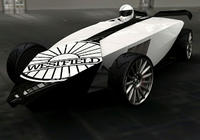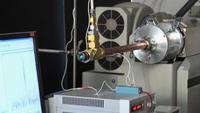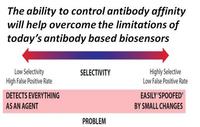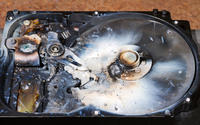-
Using plants for herbal defluoridation of drinking water

A filtration system based on a medicinal herb can quickly and easily remove “fluoride” from drinking water, say researchers in India. The technology uses parts of the plant Tridax procumbens as a biocarbon filter for the ion.
-
-
World’s first zero emission sports car is built-at-home electric car

A new partnership has developed the world’s first build at home electric race car kit, an all-electric sports car designed and engineered to support a growing demand for zero emission racing vehicles. The iRacer kit, available from £13,999, can be transformed quickly between hybrid, pure electric, or internal combustion engines.
-
-
Enabling small ships to launch and retrieve long-endurance UAVs
About 98 percent of the world’s land area lies within 900 nautical miles of ocean coastlines. Enabling small ships to launch and retrieve long-endurance UAVs on demand would greatly expand the U.S. military’s situational awareness and ability quickly and flexibly to engage in hotspots over land or water. DARPA is seeking companies to develop these systems.
-
-
Developing the next-generation of VTOL aircraft

One of the greatest challenges of the past half century for aerodynamics engineers has been how to increase the top speeds of aircraft that take off and land vertically without compromising the aircraft’s lift to power in hover or its efficiency during long-range flight. DARPA’s new VTOL X-Plane project aims to achieve higher speeds, increased efficiency, and elegant design.
-
-
Saving money and time in developing phased RF arrays
Phased radio frequency (RF) arrays use numerous small antennas to steer RF beams without mechanical movement. These electronics are invaluable for critical DoD applications such as radar, communications, and electronic warfare. These arrays, however, come with a high price tag. Current phased arrays are extremely expensive and can take many years to engineer and build.
-
-
Modified bacteria turn bio waste into fat for fuel

“Green” chemistry developed at Rice University is at the center of a new government effort to turn plant waste into fatty acids and then into fuel. A new project aims to develop a new generation of renewable energy and bio-based products from switchgrass and forestry residues and from a new hybrid of sorghum.
-
-
Battle-tested technologies no employed by the police
Technologies employed in the wars in Iraq and Afghanistan are now hitting local streets across the United States, changing how local law enforcement investigates crimes by focusing on where crimes are most likely to happen instead of where a crime has taken place.
-
-
New explosives vapor detection technology

Novel explosives detection method focuses on direct, real-time vapor detection rather than collection of explosives particles. It could change paradigm for explosives screening.
-
-
U.S. responds to China’s cyberattacks with anti-theft trade strategy
The Obama administration yesterday (Wednesday) unveiled the details of a broad strategy to counter the systemic theft by Chinese government agencies of U.S. trade and technology and trade secrets. The administration’s plan calls for new diplomatic push to discourage intellectual property theft abroad and better coordination at home to help U.S. companies protect themselves.
-
-
Chinese set to buy yet another U.S. taxpayer-backed hi-tech firm
Lawmakers yesterday expressed their concerns about the likelihood that U.S. taxpayer dollars could end up bolstering the Chinese economy. The lawmakers reacted to reports that a Chinese firm, Zhejiang Geely Holding Group, is leading the list of companies bidding for a majority stake in government-backed Fisker Automotive, and that the only serious rival of that Chinese company is a Chinese auto maker. Fisker’s main battery supplier — U.S. government-backed A123 Systems – has already been acquired by a separate Chinese firm.
-
-
Improving detection of, responses to biological warfare

Biological warfare agents pose more than a hypothetical threat to U.S. soldiers. Troops operate in hostile areas where they could come under attack from adversaries wielding bio-agents like anthrax and toxins. The first step in reacting to any such attack is knowing that it occurred. Quickly and accurately identifying the presence of airborne antigens can be difficult given their complexity, the presence of numerous similar microorganisms in the environment, and the fact that even minute quantities of a threat agent can cause infection. Researches seek to advance sensitivity and durability of antibody-based biosensors better to protect soldiers.
-
-
DHS grant to fund technology for tracking mobile devices
The University Of Alabama at Birmingham(UAB) has been given a $583,000 grant from the Department of Homeland Securityto build a system for verifying the location history and chorological track of cell phones and smart phones, tablets, and other mobile devices. The system being built could also be used to eliminate contest fraud, verify the origin of sea food, and protect national security.
-
-
New internally cured concrete increases bridge life span
Concrete is normally made by mixing portland cement with water, sand, and stone. In the curing or hardening process, water helps the concrete mixture gain strength by reacting with the cement. Traditionally, curing is promoted by adding water on top of the bridge deck surface. The new technology for internal curing provides additional water pockets inside the concrete, enhancing the reaction between the cement and water, which adds to strength and durability. This new technology is enabling Indiana to improve bridges in the state with a new “internally cured” high-performance concrete.
-
-
New bridge construction technologies to shore up U.S. infrastructure
Experts agree that there is an urgent need to construct and repair bridges across the United States. Around 70,000 bridges in the country are considered “structurally deficient” by government standards. New technology could help the United States manage its growing, and aging, infrastructure without breaking the bank or levying high taxes on citizens.
-
-
Military electronic devices disappear into the surroundings after use

Electronic devices have become necessary for military operations, but it is almost impossible to track and recover every device. At the end of operations, these devices are often found scattered across the battlefield and might be captured by the enemy and repurposed or studied to compromise DoD’s strategic technological advantage. New DARPA program — Vanishing Programmable Resources (VAPR) program — seeks transient electronics, that is, devices which would maintain the current functionality and ruggedness of conventional electronics, but, when triggered, be able to degrade partially or completely into their surroundings.
-
More headlines
The long view
New Technology is Keeping the Skies Safe
DHS S&T Baggage, Cargo, and People Screening (BCP) Program develops state-of-the-art screening solutions to help secure airspace, communities, and borders
Factories First: Winning the Drone War Before It Starts
Wars are won by factories before they are won on the battlefield,Martin C. Feldmann writes, noting that the United States lacks the manufacturing depth for the coming drone age. Rectifying this situation “will take far more than procurement tweaks,” Feldmann writes. “It demands a national-level, wartime-scale industrial mobilization.”
How Artificial General Intelligence Could Affect the Rise and Fall of Nations
Visions for potential AGI futures: A new report from RAND aims to stimulate thinking among policymakers about possible impacts of the development of artificial general intelligence (AGI) on geopolitics and the world order.
Keeping the Lights on with Nuclear Waste: Radiochemistry Transforms Nuclear Waste into Strategic Materials
How UNLV radiochemistry is pioneering the future of energy in the Southwest by salvaging strategic materials from nuclear dumps –and making it safe.
Model Predicts Long-Term Effects of Nuclear Waste on Underground Disposal Systems
The simulations matched results from an underground lab experiment in Switzerland, suggesting modeling could be used to validate the safety of nuclear disposal sites.
